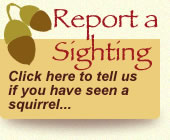Natural History of Red Squirrels
Natural History of Red Squirrels
Classification
It all began 34 million years ago with Protosciurus, the oldest known tree squirrel fossil. Squirrels in the 21st century don’t look very different from their prehistoric ancestors, but nowadays, there are at least 267 species of squirrel throughout the world, which come in a variety of shapes, sizes and colours. Squirrels belong to the Order Rodentia, characterised by their efficient gnawing front teeth and including other animals such as mice and voles. Within this Order, the Family Sciuridae covers the three groups of squirrels – flying squirrels, ground dwelling squirrels and tree squirrels, the latter of which includes both red and grey squirrels.
Distribution
 The red squirrel can be found across Europe and Asia, from the Arctic Circle in the north to the Mediterranean Sea in the south, and from China in the east to Britain in the west. Interestingly, it is only in Britain where the red squirrel is threatened, although some populations in northern Italy are also declining. Both of these areas have also been subject to the release of American grey squirrels, supporting the belief that red squirrels are being replaced by this non-native species wherever it is introduced.
The red squirrel can be found across Europe and Asia, from the Arctic Circle in the north to the Mediterranean Sea in the south, and from China in the east to Britain in the west. Interestingly, it is only in Britain where the red squirrel is threatened, although some populations in northern Italy are also declining. Both of these areas have also been subject to the release of American grey squirrels, supporting the belief that red squirrels are being replaced by this non-native species wherever it is introduced.
Squirrel Spotting
Red squirrels have fur which ranges from blonde or pale orange, through deep reddish-brown to almost black ear tufts (which are easier to spot in winter) and bushy tails, which may bleach lighter in spring and summer. Some red squirrels can have greyish flanks in summer, but their ear tufts and tail (uniformly all one colour) mean that they can be distinguished from grey squirrels, which are stockier and heavier, with mouse-like ears and a halo of white around their tail.
Master of the Trees
Red squirrels are well adapted to the woodland habitat in which they live, their light weight and agility enabling them to reach the thinnest branches at the tops of trees. They use their tails for balance, and double-jointed ankles and long claws help them to hold on when running up and down tree trunks. If they are disturbed, they will often ‘freeze’ for 5 to 10 minutes, pressing themselves against the trunk of the tree until they think it is safe to move again.
Squirrels have long whiskers which they use to find their way around inside their drey.
The Squirrel Year
Red squirrels eat a variety of different foods throughout the year. They are adapted to living and foraging in woodlands, where their diet is made up of tree seeds, nuts, berries, fungi, buds, shoots, flowers, bark, lichen, and even insects in summer. The autumn and winter seed harvest is extremely important, both for survival through the winter months, and to ensure breeding success the following spring.
 Chewed and stripped pine cones and broken nut shells (often found scattered below a favourite feeding branch or on tree stumps) are clues to show where a squirrel has been feeding.
Chewed and stripped pine cones and broken nut shells (often found scattered below a favourite feeding branch or on tree stumps) are clues to show where a squirrel has been feeding.
Squirrels can even tell good nuts from rotten ones by weighing them and shaking them in their paws. If the nut rattles, the kernel is likely to be small and shrivelled, and not worth eating.
In the autumn, squirrels can be seen gathering and storing caches of nuts and cones ready for the winter. Squirrels do not hibernate, but continue to forage for food throughout the winter, although they may not emerge from the shelter of their drey in very cold or wet weather.
During the breeding season (which usually starts in January) you may see squirrels leaping from tree to tree, then running round and round the tree trunks in mating chases. Female squirrels can have spring and summer litters, producing three young on average. However, breeding success is directly influenced by the previous autumn’s seed crop and the severity of the winter. Young squirrels, known as kittens, open their eyes at around 30 days old, and begin to venture from the drey at around 45 days. At 10 to 12 weeks they become independent from their mother and start to disperse. The young squirrels’ survival is determined largely by their first winter, with up to 85% of young perishing during harsh conditions.
Where Do Squirrels Live?
A squirrel’s home is called a drey. A red squirrel will build its drey close to the main trunk, or in the fork of a tree and is used both for rearing young and nocturnal shelter. The drey consists of a hollow ball of twigs and leaves, which is then lined with soft hair and moss. Summer dreys may also be constructed, which are flat, less protective structures used for resting during daylight hours. As an alternative to dreys, some squirrels may use natural holes in trees which are known as dens.
Click here for a printable version (pdf)

Please note this link will open a new window which will take you to the Scottish Wildlife Trust website where you can record your squirrel sightings.
Website by
Stewartry Technology





